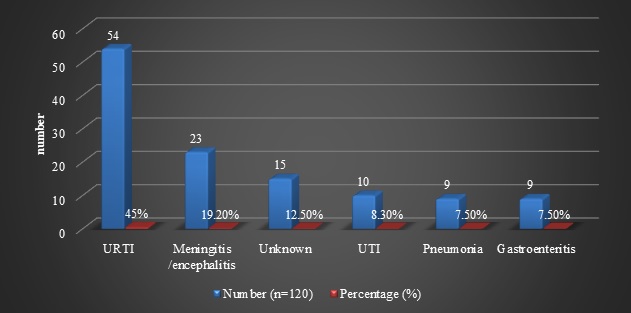Clinical profile and cerebrospinal fluid indices in children with complex febrile seizures
Abstract
Introduction: Fever with seizure is the most common type of seizure occurring in children. A seizure is a common presentation for which a child may come to the emergency and may occur in up to 10% of children presenting to the emergency. Among all these seizures, Febrile seizures (FS) are the most common type of childhood seizures, affecting 2–5% of children older than 1 month and most commonly from 6 months–5 years old. The differential diagnosis of febrile seizure includes non-epileptic events or movements, provoked seizures following a central nervous system infection, and rare forms of genetic epilepsy in which seizures typically present with fever.
Material and Methods: A hospital-based, prospective study conducted at the Department of Pediatrics, Government Medical College, and Hospital Aurangabad conducted from November 2018 to February 2020.
Results: A total of 120 cases that presented with Complex Febrile Seizures (CFS) between six months to five years of age were included. Among them, 83 (69.1%) were male and 47 (30.9%) were female children. There were a total of 63 children in 6-12 months age, 32 in 12-24 months, and 25 in the above 12 months age group.
Conclusion: In conclusion, it was found that age less than 1 year and male gender were the most significant risk factors for Complex Febrile Seizure in our area.
Downloads
References
Chin RFM, Neville BGR, Scott RC. Meningitis is a common cause of convulsive status epilepticus with fever. Arch Dis Child 2005;90:66-69.
Johnston MV. Seizures in childhood. In: Behrman RE, Kliegman RM, Jenson HB, editors. Nelson textbook of pediatrics.17th ed.Saunders press;2004. p. 1993-1994.
Kimia A, Ben-Joseph EP, Rudleo T, et al. Yield of lumbar puncture among children who present with their first complex febrile seizure. Pediatrics.2010; 126: 62-69.
Hom J, Medwid K, The low rate of bacterial meningitis in children, ages 6 to 18 months, with simple febrile seizures. AcadEmerg Med 2011; 18(11):1114-1120.
Subcommittee on Febrile Seizures. Febrile seizures: Guidelines for the neurodiagnostic evaluation of the child with a simple febrile seizure. Pediatrics. 2011;127(2):389–394.
Trainor JL, Hampers LC, Krug SE, Listernick R. Children with first-time simple febrile seizures are at low risk of serious bacterial illness. Acad Emerg Med 2001;8: 781-787.
Akpede GO, Sykes RM, Abiodun PO. Indication for lumbar puncture in children presenting with convulsions and fever of acute onset: experience in the children’s emergency room of the University of Benin Teaching Hospital, Nigeria. Ann Trop Paediatr 1992;12:4: 385-9.
Casasoprana A, Hachon Le Camus C,, et al. Value of lumbar puncture after a first febrile seizure in children aged less than 18 months. Arch Pediatr. 2013 Pil: S0929-693X (13)00238-8.
Haslam RHA. Neurological evaluation. In: Behrman RE, Kliegman RM, Jenson HB, editors. Nelson textbook of pediatrics.17th ed.Saunders press;2004. p. 1980-1981.
Akpede GO, Sykes RM. Convulsions with fever as a presenting feature of bacterial meningitis among preschool children in developing countries. Dev Med Child Neurol 1992 Jun;34:6: 524-9.
Jaffe M, Bar-Joseph G, Tirosh E. Fever and convulsions - indications for laboratory investigations. Paediatrics 1981;67: 729-31.
Laditan AA. Analysis of the results of routine lumbar puncture after a first febrile convulsion in Hofuf, Al- Hassa, Saudi Arabia. East Afr Med J 1995 June: 376-8.
Abuekteish F, Daoud AS, al-sheyyab M, Nou’man M. Demographic characteristics and risk factors of first febrile seizures: a Jordanian experience. Trop Doct 2000 Jan;30(1): 25-7.
Tavasoli A, Afsharkhas L, Edraki A. Frequency of Meningitis in Children Presenting with Febrile Seizures at Ali-Asghar Children’s Hospital. Iranian journal of child neurology. 2014;8(4):51.
Offringa M, Bossuyt PMM, Lubsen J, Ellenberg JH, Nelson KB, Knudsen FU et al.Risk factors for seizure recurrence in children with febrile seizures: A pooled analysis of individual patient data from five studies. J Pediatr. 1994;124:574– 584.
Berg AT1, Shinnar S, Hauser WA . A prospective study of recurrent febrile seizures. N Engl J Med 1992; 327: 1122-7.
Ausi Indriani, Nelly Amalia Risan, Titing Nurhayati. Five Years Study of Recurrent Febrile Seizure Risk Factors. AMJ. 2017;4(2):282–5.
Ciftci¹ M, Erdogan F, Nuhoglu C, Ceran O. Lumbar Puncture Findings in İnfants under 12 Months of Age with Simple Febrile Seizure.
Bassan H, Barzilay M, Shinnar S, Shorer Z, Matoth I, Gross‐Tsur V. Prolonged febrile seizures, clinical characteristics, and acute management. Epilepsia. 2013 Jun;54(6):1092-8.
Rider IG, Ihapa PB, Del beccaro MA, Gale JL, Joy HM, Farwell JR, Mendelman PM. Cerebrospinal fluid analysis in children.

Copyright (c) 2020 Author (s). Published by Siddharth Health Research and Social Welfare Society

This work is licensed under a Creative Commons Attribution 4.0 International License.


 OAI - Open Archives Initiative
OAI - Open Archives Initiative


